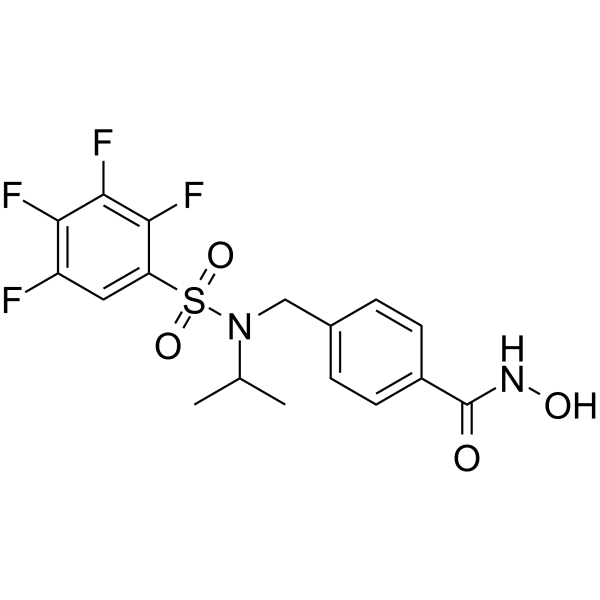2490284-25-6
| Name | NN-390 |
|---|
| Description | NN-390 is a potent and selective HDAC6 inhibitor, with an IC50 of 9.8 nM. NN-390 penetrates the blood-brain barrier (BBB). NN-390 shows study potential in metastatic Group 3 MB (medulloblastoma)[1]. |
|---|---|
| Related Catalog | |
| Target |
HDAC2:>5 μM (IC50) HDAC1:>5 μM (IC50) HDAC6:9.8 nM (IC50) HDAC3:>1 μM (IC50) HDAC8:>1 μM (IC50) HDAC11:>1 μM (IC50) |
| In Vitro | NN-390 exhibits cellular potency with IC50 values of 1.19 μM in MV4-11 cells and 1.38 μM in MM.1S cells while having minimal effects on noncancerous counterparts (IC50 > 50 μM in MRC-9)[1]. NN-390 (72 h) strongly decreases proliferation in HD-MB03 cells, with an IC50 of 0.13 μM, and significantly impairs self-renewal of BTIC-enriched HD-MB03s[1]. NN-390 (0-2 μM, 1 h) markedly increases acetylation of α-tubulin and minimally changes acetylated histone H3[1]. NN-390 (6 h) results in acetylation of α-tubulin from concentrations as low as 0.1 μM (0-0.2 μM), and dose-dependent increases in acetylation of α-tubulin (0-0.2 μM)[1]. NN-390 (0-2 μM, 24 h) promotes cancer cells apoptosis in MV4-11 cells[1]. Immunofluorescence Cell Line: HeLa cells[1] Concentration: 0, 0.1, 0.25, 1, 2 μM Incubation Time: 1 h Result: Markedly increased acetylation of α-tubulin and minimally changed acetylated histone H3. Western Blot Analysis Cell Line: AML (MV4-11) cells[1] Concentration: 0, 0.1, 0.5, 1, 5 μM Incubation Time: 6 h Result: Resulted in acetylation of α-tubulin from concentrations as low as 0.1 μM and with limited acetylation of histone H3 at only the highest concentration of 5 μM. Western Blot Analysis Cell Line: Group 3 MB (HD-MB03) cells[1] Concentration: 0, 0.053, 0.106, 0.158, 0.211 μM Incubation Time: 6 h Result: Dose-dependent increased in acetylation of α-tubulin from the lowest concentration of 53 nM, with no observable change in acetylation of off-target histone H3 up to 211 nM. Apoptosis Analysis Cell Line: MV4-11 cells[1] Concentration: 0, 0.25, 0.75, 1, 2 μM Incubation Time: 24 h Result: Promoted cancer cells apoptosis, 39% of cancer cells were undergoing late-stage apoptosis after 18 h at 2 μM, and 11% of cells were in the late apoptosis stage at 0.25 μM. |
| In Vivo | NN-390 (male CD-1 mice, 20 mg/kg, IP, single dose) increases plasma stability[1]. NN-390 can improve PAMPA (parallel artificial membrane permeability assay)-BBB (blood-brain barrier) score[1]. Pharmacokinetic Parameters of NN-390 in male male CD-1 mice[1]. Compound KT-531 5a; NN-390 t1/2 (h) 1.05 1.90 Cmax (ng/mL) 493 750 AUClast (h*ng/mL) 1576 2523 AUClnf (h*ng/mL) 1519 2548 AUC/D (h*ng/mL) 79 126 Animal Model: CD-1 mice (male, n=3)[1] Dosage: 20 mg/kg Administration: IP, single dose (Pharmacokinetic Analysis) Result: Had a half-life of 115 min in human plasma, a 2.8-fold increase in stability. |
| References |
| Molecular Formula | C17H16F4N2O4S |
|---|---|
| Molecular Weight | 420.38 |
